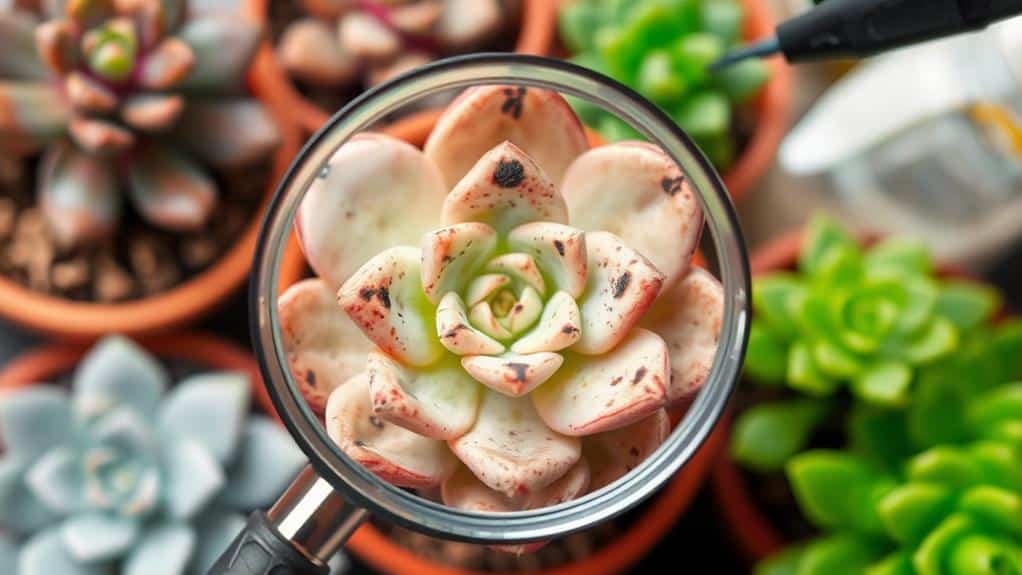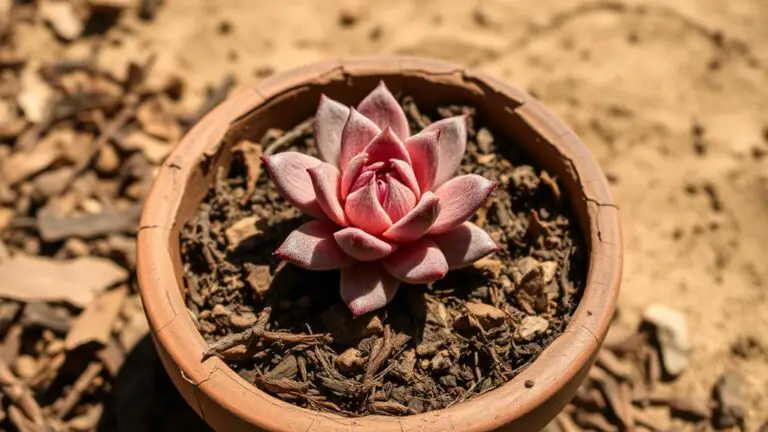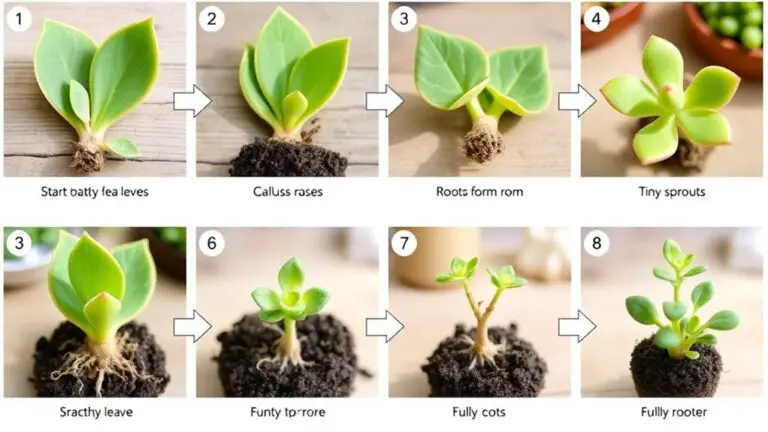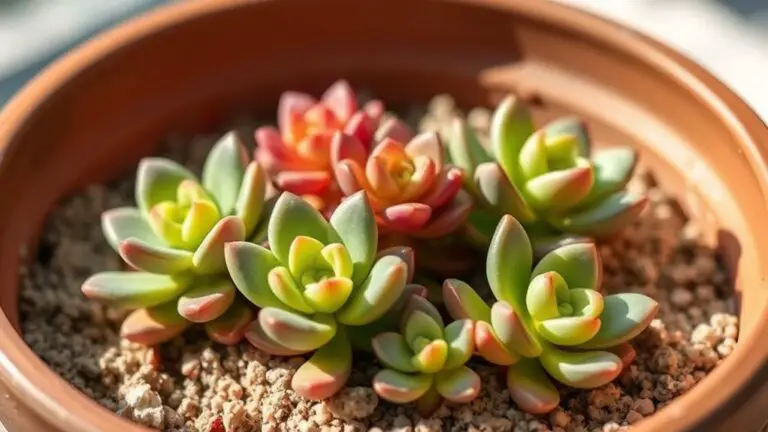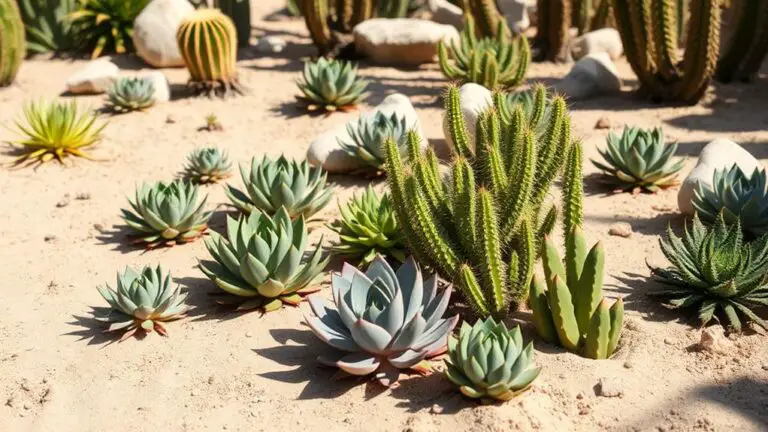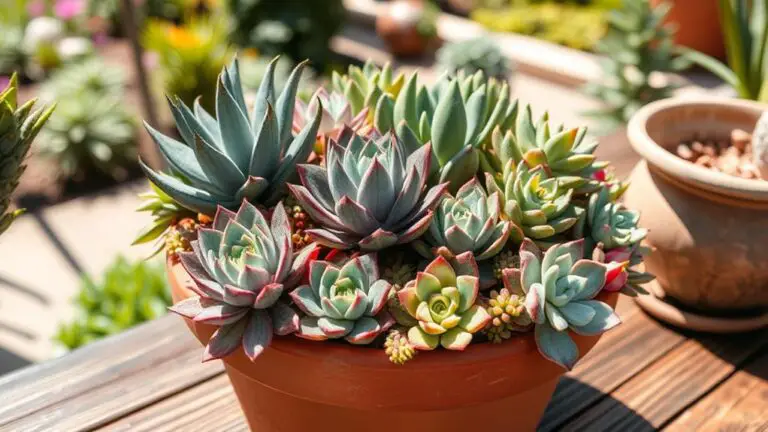How to Identify and Treat Black Spots on Succulents
When you notice black spots on your succulents, it's essential to identify the cause quickly to prevent further damage. These spots can result from various issues, including overwatering, sunburn, pests, or even fungal infections. Overwatering often leads to mushy leaves and root rot, while sunburn appears as dark patches. Inspect your plants regularly for pests like mealybugs and spider mites, and use appropriate treatments such as alcohol or neem oil. Understanding these initial steps can help you take action, but what about viral infections and general care tips to prevent black spots altogether?
Causes of Black Spots
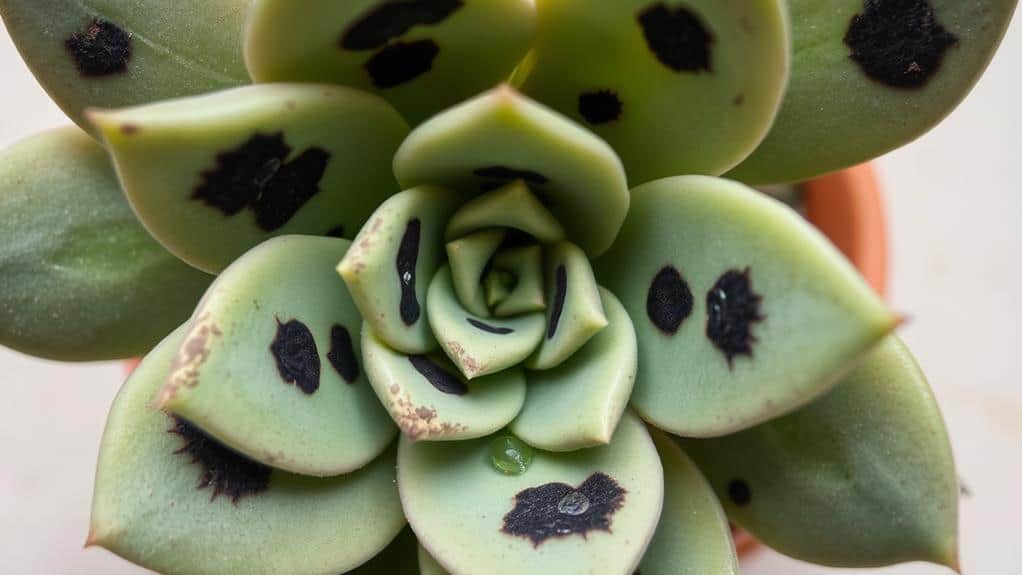
Black spots on succulents are a clear signal that something's wrong with your plant. When you notice these spots, it's important to figure out the cause quickly.
One common reason is fungal infections, which thrive in high humidity and can spread rapidly. Treating your plant with fungicides can help, but it's essential to act fast.
Another culprit could be excess sunlight. If your succulent has been in a shady spot and then suddenly gets too much direct sunlight, it might develop black or brown patches. This sunburn can damage the leaves, so try moving your plant to a less intense light spot.
Pest infestations are also a major issue. Mealybugs and spider mites can leave behind small black spots, along with other signs like yellowing leaves and sticky residue. Inspect your plant closely and treat any pests promptly to prevent further damage.
Lastly, nutrient deficiencies, especially in potassium, can cause dark spots to appear. Ensuring your succulent gets balanced fertilization can help keep it healthy and vibrant.
Overwatering Issues
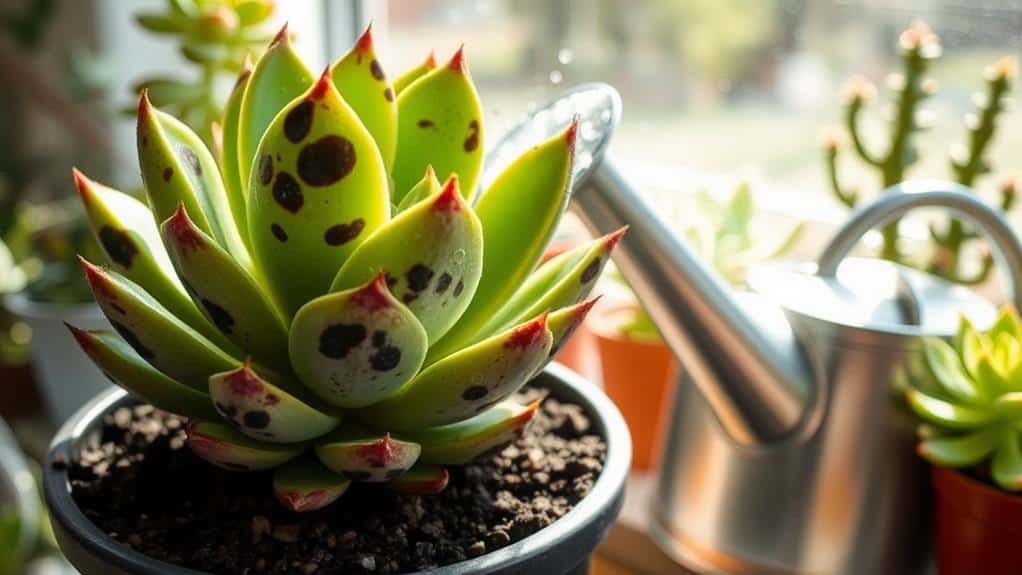
Overwatering is a common issue that can cause your succulent's leaves to wilt, become mushy, and emit a foul odor.
If you notice these symptoms, it's important to act quickly by trimming away the damaged parts and repotting the plant in fresh, dry soil.
Make sure to let the soil dry out completely between waterings to prevent future problems.
Symptoms of Overwatering
Succulents showing signs of distress often point to overwatering issues. When you notice black or brown spots on your succulent's leaves, it's a clear signal something's wrong. Overwatering is usually the culprit, causing the succulent tissue to bloat. This leads to wilting and a mushy texture on the affected leaves or stems.
These black spots often indicate root rot, a severe condition that can ultimately kill your plant if not addressed promptly. You might also notice a foul odor from the infected leaves, a clear sign that the plant tissue is decaying. This unpleasant smell further confirms that your succulent is suffering from overwatering.
To prevent further damage, you should act quickly. Identifying these symptoms early on is vital for saving your plant. Proper watering practices are key. Allow the soil to dry out completely between watering sessions to avoid these distressing symptoms.
Steps for Recovery
Once you've recognized the symptoms of overwatering, it's time to take immediate action to save your succulent. First, stop watering and let the soil dry out completely. Overwatering can cause root rot and black spots, damaging your plant.
Next, carefully remove your succulent from its pot and inspect the roots. Trim away any mushy or dark areas, keeping only the healthy root sections.
Afterwards, repot your succulent in fresh, well-draining soil. This step is vital to prevent future moisture retention. Be sure to dispose of any infected soil to avoid fungal pathogens that might harm your plant further.
Once repotted, it's important to monitor the plant closely. Adjust your watering habits to guarantee the top inch of soil dries out between waterings. This helps prevent recurrence of the issue.
Keep an eye on your succulent, looking for any new black spots or infected leaves.
Managing Sunburn
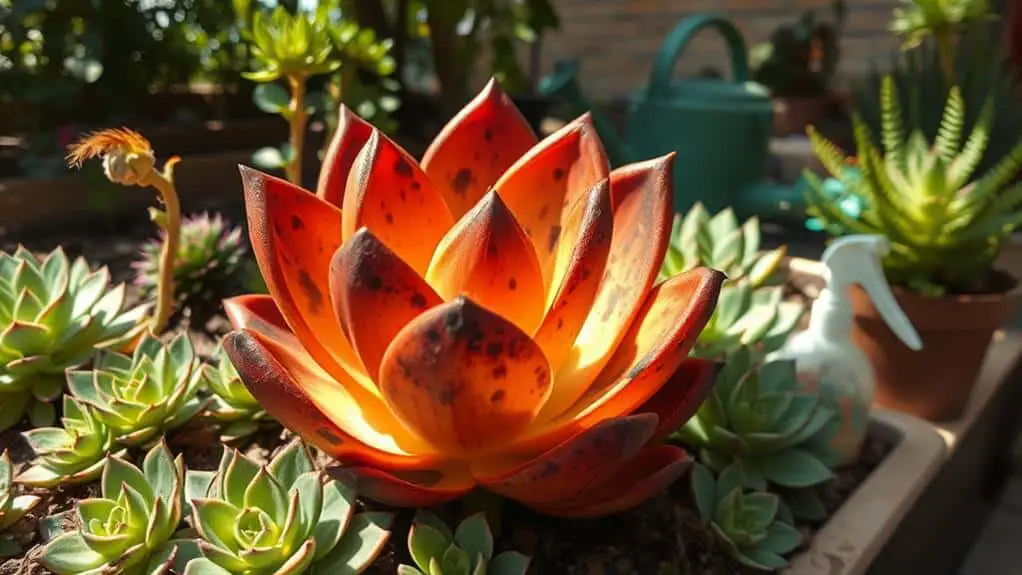
Managing sunburn on your succulents involves a few simple steps to keep them healthy and vibrant.
Gradually introduce your plants to more sunlight over several days, starting with just a few hours each morning or late afternoon.
Also, provide shade during the hottest part of the day and guarantee good ventilation to keep humidity down and prevent additional issues.
Gradual Light Acclimation
To prevent sunburn in your succulents, start by gradually acclimating them to sunlight. Sudden exposure to direct sunlight can cause severe damage to their leaves.
Begin by placing your succulents in a shaded area for a few days. Then, slowly introduce them to direct sunlight for short periods, increasing the exposure incrementally. This gradual acclimation helps prevent the spread of sunburn damage.
Monitor the temperature closely. When temperatures rise above 90°F, the risk of sunburn increases considerably. Provide immediate shade during extreme heat to avoid causing harm to your plants.
Damaged leaves won't heal, so remove them promptly. This allows your succulent to focus its energy on producing new, healthy growth.
Using a 6-needle shading net can be very effective. It shields your succulents from intense sunlight while maintaining adequate air circulation.
Proper air circulation is key to keeping your plants healthy. The shading net helps you manage the light exposure without stressing the plants.
Shade and Ventilation
As you continue to protect your succulents from sunburn, focusing on shade and ventilation becomes essential. Providing shade during peak sunlight hours is vital, especially when temperatures soar above 90°F (32°C). Gradually introduce your succulents to increased light exposure over several days to prevent stress and sunburn. Using a 6-needle shading net can effectively diffuse harsh sunlight, guaranteeing your plants stay cool even during extreme heat.
Guaranteeing proper ventilation is just as important. Good airflow around your succulents helps inhibit bacterial growth and reduces humidity, which is necessary for preventing sunburn and fungal spores. Regularly monitor the environment to guarantee adequate airflow, as poor ventilation can increase humidity levels, making your succulents more susceptible to damage.
| Action | Benefit |
|---|---|
| Provide Shade | Reduces risk of sunburn |
| Use Shading Net | Protects from extreme conditions |
| Guarantee Good Ventilation | Inhibits bacterial growth and fungi |
Pest Management
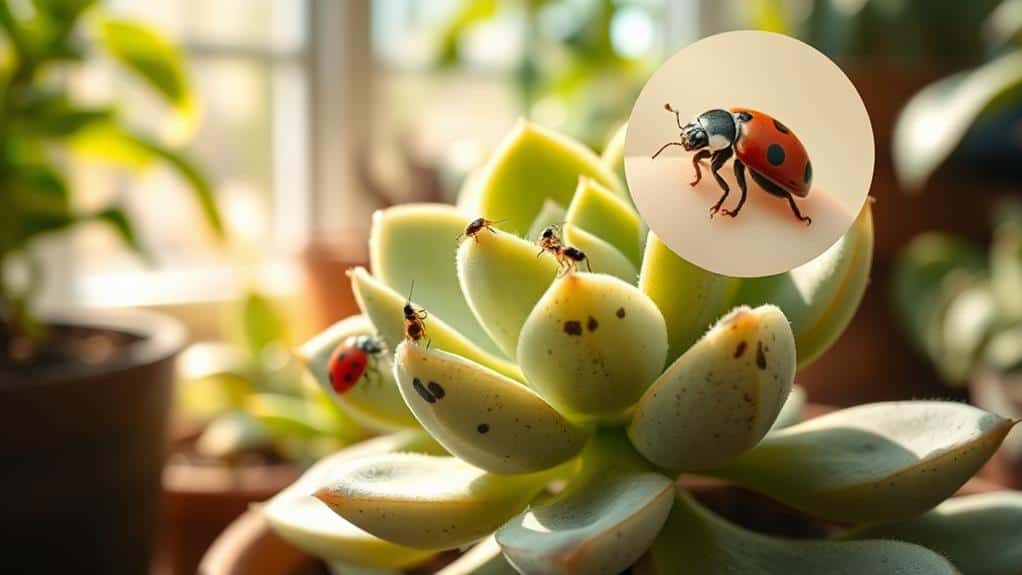
Regularly inspecting your succulents is essential for catching pest infestations early, such as the white fluff from mealybugs or the sticky residue from aphids.
By addressing these issues promptly, you can keep your plants healthy and thriving.
Here's how you can manage pests effectively:
- Use 75% Alcohol: Dip a cotton ball in 75% alcohol and gently wipe the affected areas. This will remove mealybugs and other pests. Confirm you cover all areas for the best results.
- Apply Insecticidal Soap or Neem Oil: These natural treatments can handle a variety of pests. Follow the label instructions for proper dilution and application frequency. They're safe and effective.
- Isolate Infested Plants: Move any infested plants away from your healthy ones immediately. This prevents the pests from spreading. Keep a close monitor on neighboring plants to catch any signs early.
- Sterilize Pruning Tools: After cutting infected leaves, always sterilize your pruning tools. This stops the transmission of pests and diseases to other plants in your collection.
Viral Infections
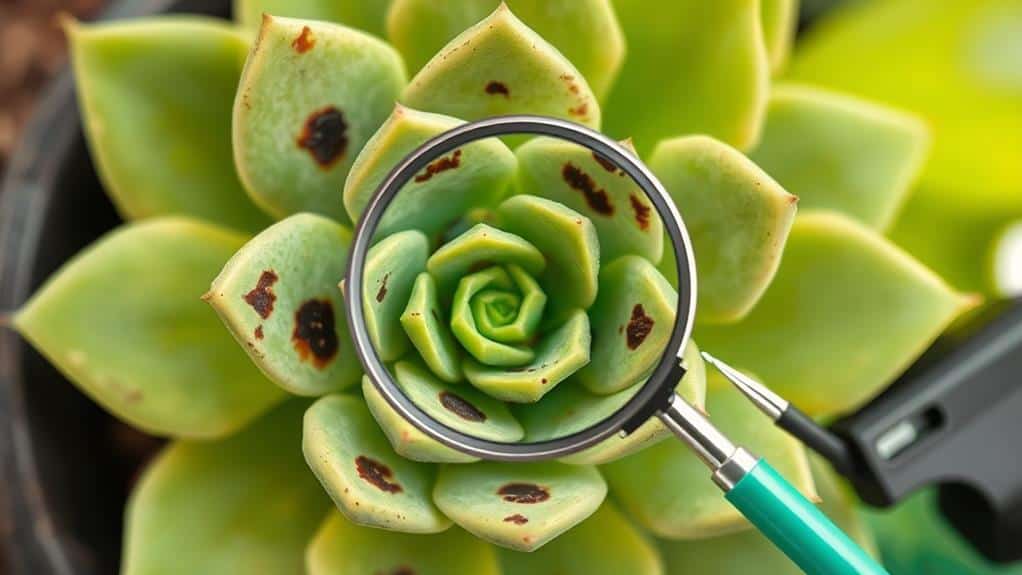
Viral infections in succulents can show up as spots or discoloration on the underside of leaves, often causing them to yellow and distort.
If you notice these symptoms, isolate the infected plant to keep the virus from spreading to healthy ones nearby.
Always sterilize your tools after handling infected leaves to prevent the virus from spreading further.
Symptoms of Infection
When dealing with succulents, one of the most alarming symptoms of infection is the appearance of black spots on the underside of leaves, signaling a potential viral issue.
These spots on succulents can indicate systemic distress and may lead to overall plant decline. Viral infections, like the black ring virus, cause dark, sunken areas that spread over time and are often irreversible.
To recognize symptoms of viral infections in your succulents, watch for these signs:
- Black Spots: Dark, sunken areas on the underside of leaves are a key indicator.
- Stunted Growth: Infected plants often show signs of slowed or abnormal growth.
- Distorted Leaves: Leaves may become twisted or misshapen, making it hard to diagnose.
- Yellowing: A yellow hue can spread through the plant, mimicking nutrient deficiencies.
It's essential to isolate infected plants immediately to prevent the spread of the virus to nearby healthy succulents.
Many viruses can be transmitted through physical contact or contaminated tools. Continuous monitoring is critical since treatment options are limited.
Treatment and Prevention
Recognizing the symptoms of viral infections in your succulents is just the first step. When you notice those dreaded dark spots, especially under the leaves, swift action is key.
Start by isolating the affected plants immediately to prevent the virus from spreading to your healthy succulents. This separation minimizes the risk of further infection.
Next, it's vital to sterilize your gardening tools after using them on infected plants. Use a household disinfectant or a bleach solution to clean the tools thoroughly. This simple step can make a big difference in halting the spread of viral infections.
Unfortunately, there's no cure for viral infections in succulents. Your best bet is to remove and dispose of plants that are severely affected. This might feel harsh, but it protects the rest of your collection from the black spots and other symptoms.
Continuous monitoring is essential. Keep an eye out for any new signs of infection. Early detection helps you manage and control outbreaks more effectively.
Fungal Infections

Fungal infections in succulents often appear as black spots on leaves, with anthracnose being a frequent offender. These infections thrive in high humidity and poor ventilation.
If you notice black spots on your succulent's leaves, it's a sign that fungal spores have started to take hold. Without prompt treatment, these spots can spread, causing rapid leaf shedding and black rot.
To effectively treat fungal infections and protect your affected plant, follow these steps:
- Isolate the Infected Plant: Move the plant away from your other succulents to prevent the fungi from spreading.
- Apply Fungicide: Use fungicides like diluted benzopyrazole or mancozeb. Carefully apply it to the black spots and surrounding areas.
- Monitor Environmental Conditions: Keep an eye on humidity levels and guarantee good air circulation around your succulents.
- Proper Watering Techniques: Avoid overhead watering and use well-draining soil to reduce the risk of fungal infections.
Sooty Mold Prevention

Ensuring your succulents are free of sooty mold involves a few key practices that focus on proper plant care and pest management.
First, maintaining good ventilation around your plants is vital. Adequate airflow helps prevent the damp conditions that sooty mold thrives in. Make sure your succulents aren't overcrowded and have enough space between them.
Regularly inspect your succulents for insect pests like mealybugs and aphids. These pests produce honeydew, a sticky substance that encourages sooty mold growth. By catching infestations early, you can remove the pests before they cause major issues.
Cleaning your succulent leaves with a damp cloth or water can help remove existing sooty mold and prevent its accumulation. This simple task promotes healthier plant conditions by keeping the leaves clean and free from mold.
Proper watering techniques are also essential. Water at the base of the plant rather than on the leaves to reduce moisture on the foliage, which helps deter mold growth.
If you notice sooty mold, using fungicides like mancozeb can be effective. Combining fungicide treatment with pest management addresses the root cause and keeps your succulents healthy.
Follow these steps, and your succulents will thrive mold-free!
Insect Infestations
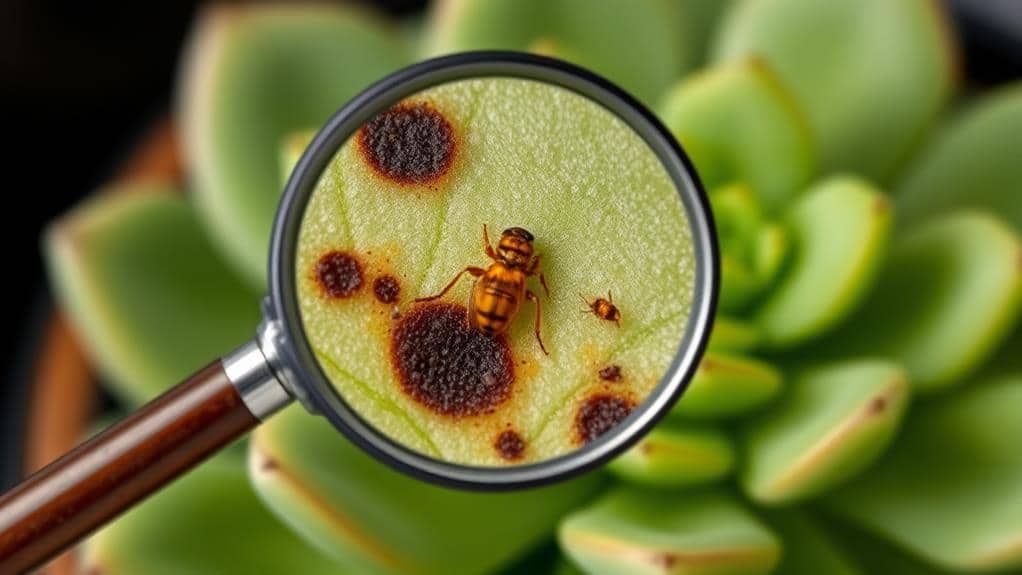
Dealing with insect infestations on your succulents is critical for maintaining their health and appearance. Insects like mealybugs, spider mites, and cochineal insects can cause serious damage, including black spots on leaves.
To keep your succulents healthy, you need to recognize and treat these pests quickly.
Here's what to look for and how to handle it:
- Mealybugs: These pests look like white, fluffy blobs on your plant. They cause yellowing leaves and stunted growth. Dab them with 75% alcohol on a cotton ball to kill them.
- Spider Mites: Found on the undersides of leaves, they create tiny webs and cause leaf discoloration and drop. Spray neem oil to remove them effectively.
- Cochineal Insects: These appear as small white or grayish bumps, especially on cacti. They produce carminic acid, which harms the plant. Carefully remove them and treat the area with neem oil or alcohol.
- Regular Inspection: Look for pest signs like sticky residue or webbing. Early detection prevents infestations from spreading to other plants.
General Care Tips
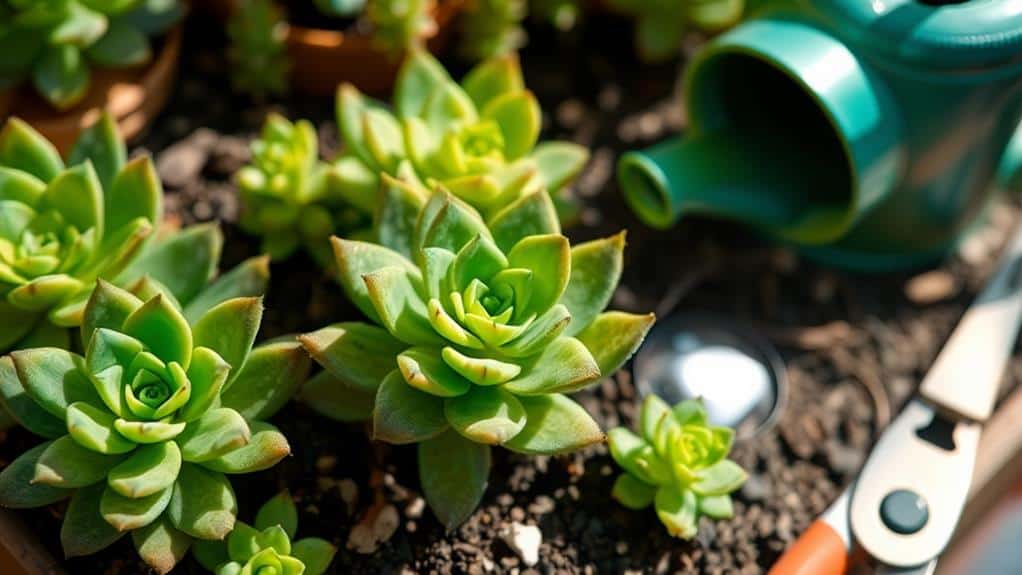
Proper care is essential to keep your succulents looking vibrant and healthy.
First, make sure to plant your succulents in well-draining soil. Using potting mixes specifically designed for cacti and succulents helps prevent root rot, which can lead to black spots on the leaves.
Watering is vital. Only water your succulents when the top inch of soil is dry. Overwatering can cause root rot and black spots, so it's better to err on the side of caution. A good rule to follow is "less is more" when it comes to watering succulents.
Light is another important factor. Succulents need bright, indirect sunlight. Too much direct sunlight can scorch the leaves, causing dark patches. To avoid sunburn, place your succulents where they get plenty of light but not direct sun for extended periods.
Regularly inspect your succulents for pests like mealybugs and spider mites. Early detection and treatment can prevent infestations that stress the plant and create black spots.
Don't forget to fertilize during the growing season. Use a diluted succulent fertilizer in spring and summer to provide essential nutrients. This promotes healthy growth and keeps your succulents thriving.
Prevention Techniques
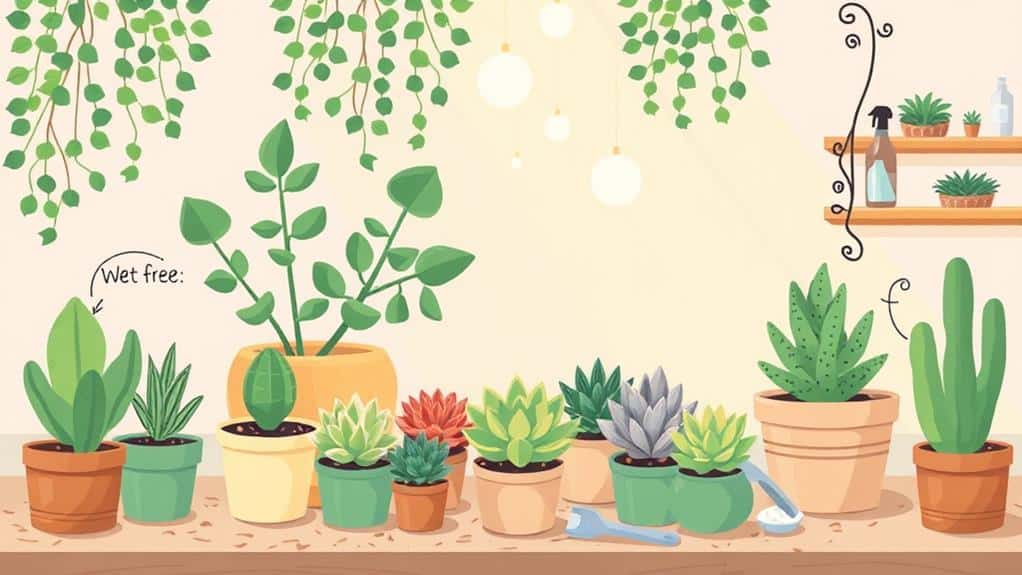
Preventing black spots on succulents involves a few essential steps that can make all the difference. By following these tips, you'll keep your succulents healthy and vibrant.
- Use well-draining soil: Make sure your succulents are planted in soil that allows water to flow through easily. This helps prevent black spots by reducing the risk of root rot, which can occur if the roots sit in water for too long.
- Avoid watering on the leaves: Water your succulents only when the top inch of soil is dry. When you do water, aim for the soil and not the leaves. Getting water on the leaves can cause fungal infections, leading to those dreaded black spots.
- Maintain good air circulation: Space your plants adequately and avoid overcrowding. Good air circulation helps keep humidity levels down and prevents fungal growth. This will keep your succulents looking their best.
- Inspect for pests: Regularly check your succulents for any signs of pests or disease. Early detection is key to preventing problems from getting worse. If you spot anything unusual, take action immediately to protect your plants.
Frequently Asked Questions
How to Get Rid of Black Spots on Succulents?
You'll need to identify the cause first. If it's overwatering, stop watering and trim damaged roots. For sunburn, acclimate gradually. Fungal infections need fungicide, and pests require treatment with alcohol or insecticidal soap.
How Do You Treat Black Fungus on Succulents?
To treat black fungus on succulents, isolate the infected plant, apply a fungicide like mancozeb, remove infected parts with sterilized tools, and place the plant in a well-ventilated area. Monitor it regularly for signs of recovery.
What Fungicide Is Safe for Succulents?
You can safely use Benzimidazole fungicides like Carbendazim and Mancozeb for succulents. Neem oil is also a natural option. Always test on a small area first and apply during dry conditions to avoid complications.
How Do You Get Rid of Black Rot on Succulents?
To get rid of black rot on succulents, isolate the plant, trim infected parts with sterilized tools, inspect and cut away rotten roots, and repot in well-draining soil. Adjust watering habits to prevent recurrence.
Conclusion
You've got this! By knowing the causes of black spots on succulents and how to treat them, you're well on your way to keeping your plants healthy. Remember to check for signs of overwatering, sunburn, pests, and infections regularly. Use the right treatments like fungicides and neem oil, and don't forget to isolate affected plants. With a bit of care and attention, your succulents will thrive. Keep at it, and happy gardening!

